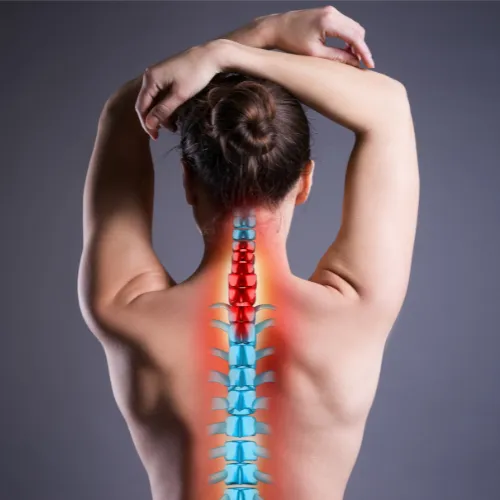Mitzvah Sessions with Milica
People have a lot of hang-ups when it comes to sex – ones that keep us from exploring our desires and truly knowing ourselves. Just beyond our judgements, though, is a whole ocean of pleasure.
My show “The Pleasure Zone,” and my Sex & Intimacy coaching practice were born from my desire to help people put aside their judgements. I talk about sex with the world – playfully sharing information that dives into the physical, mental, emotional, spiritual, and social aspects of sexuality. My mission is to create more pleasure in the world – one listener at a time.
My career kicked off with psychology studies at the University of Windsor, where I found myself repeatedly drawn to courses on sexuality. That’s where my fascination with all things sexual – and my direct and playful approach to sex – was born.
Gentle Movement for Pain Relief, Stress Reduction & Natural Alignment
The Mitzvah Technique is a unique form of bodywork and movement education designed to release tension, ease pain, and restore the body’s natural rhythm. Rooted in principles similar to the Alexander Technique and Feldenkrais Method, this gentle, non-invasive practice was created by Nehemia Cohen and has helped countless people regain comfort, mobility, and ease in daily life.
Unlike massage or chiropractic work, the Mitzvah Technique doesn’t force change—it re-educates the body to move more naturally and efficiently, allowing long-lasting relief. Sessions are done fully clothed and are safe for people of all ages and mobility levels.
With decades of experience in somatic movement, trauma recovery, and body-centered healing, Milica offers a safe, compassionate space for your body to unwind and re-learn its natural rhythm. Her sessions are tailored to your unique needs, helping you reconnect with comfort, ease, and freedom of movement.
How the Mitzvah Technique Works
* The Mitzvah Mechanism – This method focuses on the relationship between your head, neck, and back. When these areas are properly aligned and free to move, the rest of your body follows—releasing tension and restoring balance.
* Gentle, Guided Movements – Through soft hands-on guidance and simple exercises, your body learns how to let go of stress and return to its natural state of ease.
* Everyday Integration – The technique teaches you how to apply new movement patterns into daily activities like sitting, walking, and standing, making the benefits long-lasting.
Benefits of the Mitzvah Technique
* Reducing stress and emotional overwhelm
* Supporting chronic fatigue and burnout recovery
* Managing autoimmune and inflammatory conditions
* Addressing trauma stored in the body
* Supporting recovery after illness or injury
* Balancing energy for animals and pets as well as humans
Who is The Mitzvah Technique for?:
* Individuals living with pain, stiffness, or limited mobility
* People recovering from injury or surgery
* Those experiencing stress, anxiety, or tension-related discomfort
* Anyone seeking a gentle, non-invasive approach to healing and alignment
Gentle Movement for Pain Relief, Stress Reduction & Natural Alignment
The Mitzvah Technique is a unique form of bodywork and movement education designed to release tension, ease pain, and restore the body’s natural rhythm. Rooted in principles similar to the Alexander Technique and Feldenkrais Method, this gentle, non-invasive practice was created by Nehemia Cohen and has helped countless people regain comfort, mobility, and ease in daily life.
Unlike massage or chiropractic work, the Mitzvah Technique doesn’t force change—it re-educates the body to move more naturally and efficiently, allowing long-lasting relief. Sessions are done fully clothed and are safe for people of all ages and mobility levels.

Gentle Movement for Pain Relief, Stress Reduction & Natural Alignment
The Mitzvah Technique is a unique form of bodywork and movement education designed to release tension, ease pain, and restore the body’s natural rhythm. Rooted in principles similar to the Alexander Technique and Feldenkrais Method, this gentle, non-invasive practice was created by Nehemia Cohen and has helped countless people regain comfort, mobility, and ease in daily life.
Unlike massage or chiropractic work, the Mitzvah Technique doesn’t force change—it re-educates the body to move more naturally and efficiently, allowing long-lasting relief. Sessions are done fully clothed and are safe for people of all ages and mobility levels.
With decades of experience in somatic movement, trauma recovery, and body-centered healing, Milica offers a safe, compassionate space for your body to unwind and re-learn its natural rhythm. Her sessions are tailored to your unique needs, helping you reconnect with comfort, ease, and freedom of movement.
How the Mitzvah Technique Works
* The Mitzvah Mechanism – This method focuses on the relationship between your head, neck, and back. When these areas are properly aligned and free to move, the rest of your body follows—releasing tension and restoring balance.
* Gentle, Guided Movements – Through soft hands-on guidance and simple exercises, your body learns how to let go of stress and return to its natural state of ease.
* Everyday Integration – The technique teaches you how to apply new movement patterns into daily activities like sitting, walking, and standing, making the benefits long-lasting.
Benefits of the Mitzvah Technique
* Reducing stress and emotional overwhelm
* Supporting chronic fatigue and burnout recovery
* Managing autoimmune and inflammatory conditions
* Addressing trauma stored in the body
* Supporting recovery after illness or injury
* Balancing energy for animals and pets as well as humans
Who is The Mitzvah Technique for?:
* Individuals living with pain, stiffness, or limited mobility
* People recovering from injury or surgery
* Those experiencing stress, anxiety, or tension-related discomfort
* Anyone seeking a gentle, non-invasive approach to healing and alignment
With decades of experience in somatic movement, trauma recovery, and body-centered healing, Milica offers a safe, compassionate space for your body to unwind and re-learn its natural rhythm. Her sessions are tailored to your unique needs, helping you reconnect with comfort, ease, and freedom of movement.
How the Mitzvah Technique Works:
* The Mitzvah Mechanism – This method focuses on the relationship between your head, neck, and back. When these areas are properly aligned and free to move, the rest of your body follows—releasing tension and restoring balance.
* Gentle, Guided Movements – Through soft hands-on guidance and simple exercises, your body learns how to let go of stress and return to its natural state of ease.
* Everyday Integration – The technique teaches you how to apply new movement patterns into daily activities like sitting, walking, and standing, making the benefits long-lasting.

Benefits of the Mitzvah Technique
* Reducing stress and emotional overwhelm
* Supporting chronic fatigue and burnout recovery
* Managing autoimmune and inflammatory conditions
* Addressing trauma stored in the body
* Supporting recovery after illness or injury
* Balancing energy for animals and pets as well as humans
Who is The Mitzvah Technique for?:
* Individuals living with pain, stiffness, or limited mobility
* People recovering from injury or surgery
* Those experiencing stress, anxiety, or tension-related discomfort
* Anyone seeking a gentle, non-invasive approach to healing and alignment




What Clients have to Say
Have Questions? Book a Free Discovery Call with Milica
Talking about your body, your health, or your intimacy doesn’t have to feel awkward. With Milica, it feels like chatting with someone who truly gets it—safe, compassionate, & refreshingly real. She’ll help you explore your questions and uncover what’s possible for your healing and pleasure. Ready to see for yourself? Book your free discovery call below.
Have Questions? Book a Free Discovery Call with Milica
Talking about your body, your health, or your intimacy doesn’t have to feel awkward. With Milica, it feels like chatting with someone who truly gets it—safe, compassionate, & refreshingly real. She’ll help you explore your questions and uncover what’s possible for your healing and pleasure. Ready to see for yourself? Book your free discovery call below.
Copyright 2025. Milica Jelenic. All Rights Reserved.







